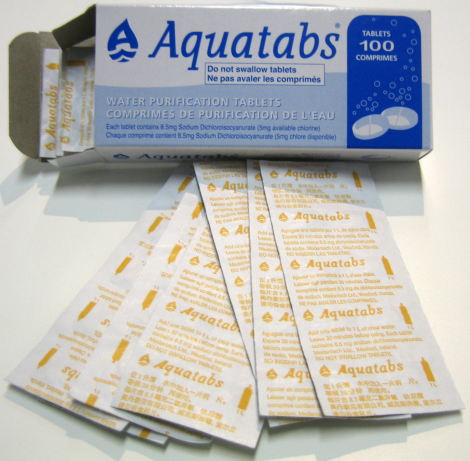CHLORINE, 20mg, NaDCC 33mg, for disinfection 5l water, tab
Valid Article
CHLORINE, 20mg, NaDCC 33mg, for disinfection 5l water, tab
Definition
Synonym
Sodium dichloro-s-triazinetrione or sodium troclosene.
Specifications
Transport Dangerous Goods
NaDCC, both in dihydrate and in anhydrous form, is regulated for air transport, with the following conditions:
- UN 3077
- Requires specific packaging and labelling until final destination
Ask for an MSDS (Material Safety Data Sheet) from your supplier; this should contain all necessary information.
Instructions for use
Strength of solutions is expressed in terms of available chlorine content (either in g or mg per litre, in parts per million (ppm), or as a percentage).
=> 20 mg/litre = 20 ppm = 0.002%
This strength is intended only for disinfecting small quantities of drinking water.
Dissolve:
- One 20 mg tablet in 4 litre of clean water. Allow to react for at least 30 minutes before drinking.
The above dosing is recommended by the manufacturer. Actual chlorine demand might differ from water to water, especially when chlorinating surface water. It is highly recommended to carry out a jar test to define appropriate dosing.
Turbid water should first be brought to a turbidity of <5 NTU before being treated with chlorine. To reduce turbidity, turbid water should be filtered, clarified or allowed to settle.
For large-scale water treatment, NaDCC or calcium hypochlorite granules (HTH).
See "Public Health Engineering in Precarious Situations", MSF, 2nd edition 2010:
- T.B. 2.19 Chlorine-generating products
- T.B. 2.20 Preparation and use of chlorine solutions for disinfection
- T.B. 2.21 Batch chlorination of drinking water
- T.B. 2.22 Monitoring chlorination
Read the household water treatment hand book (MSF2015) T.B. (Technical Briefs) chapters 1 and 2 before starting.
T.B. chapter 1 describes the pre-test to be performed before the distribution as it will indicate whether the full treatment (pre-treatment + disinfection) is required and if both chemical consumables must be distributed.
To ensure appropriation of the kit and use of treatment it is essential to combine distribution and demonstration and use sensitisation tools. Follow the distribution procedure described in T.B. chapter 4.
See haswell "Public Health Engineering in Precarious Situations", MSF, 2nd edition, 2010:
- T.B. 2.20 Preparation and use of chlorine solutions for disinfection
Remark
Use a pool-tester to check the presence of free residual chlorine.
See "Public Health Engineering in Precarious Situations", MSF, 2nd edition, 2010:
- T.B. 2.22 Monitoring chlorination
Precautions for Use
- NaDCC in blister tablets is used only to prepare drinking water and not as a disinfectant. Larger tablets from 1 gram could be used as disinfectant.
- Prepare solutions in non-metal containers, immediately before use.
- Avoid inhaling vapour and dust when handling chlorine.
- Do not expose to a naked flame, and do not incinerate.
- Never mix NaDCC solution with calcium hypochlorite powder: the mixture undergoes a chemical reaction and may explode!
- Do not mix with detergents since toxic chlorine gas could be released.
- Do not mix with acid solutions since this releases toxic chlorine gas.
- Do not mix or store NaDCC with fuel.
Storage
Store in a dry and well-ventilated place, out of direct sun light.
Do not store in the same place as fuel and other petroleum products.
Shelf-life in good storage conditions: 5 years for blister packs.
Waste management
Contact your WHS technical referent for disposal of expired or damaged batches of NaDCC.
| H302 | Harmful if swallowed |
| H319 | Causes serious eye irritation |
| H335 | May cause respiratory irritation |
| H410 | Very toxic to aquatic life with long lasting effects |
| EUH031 | Contact with acids liberates toxic gas. |
| P402 + P404 | Store in a dry place. Store in a closed container. |
| P233 | Keep container tightly closed. |
| P271 | Use only outdoors or in a well-ventilated area. |
| P280 | Wear protective gloves/protective clothing/eye protection/face protection |
| P301 + P310 | IF SWALLOWED: Immediately call a POISON CENTER or doctor/physician. |
| P501 | Dispose of contents/container to location in accordance with local and regional/ national/ international regulations |
| P305 + P351 + P313 | IF IN EYES: rinse continuously with water for several minutes. Get medical advice/attention |



![[SDISNADC1T-] CHLORINE, 1 g (NaDCC / dichloroisocyan. sodium 1.67 g), tab.](/web/image/product.template/570806/image_256/%5BSDISNADC1T-%5D%20CHLORINE%2C%201%20g%20%28NaDCC%20-%20dichloroisocyan.%20sodium%201.67%20g%29%2C%20tab.?unique=9257296)
![[KWATMHHWT3-] MODULE, household WATER TREATMENT, consumables](/web/image/product.template/551928/image_256/%5BKWATMHHWT3-%5D%20MODULE%2C%20household%20WATER%20TREATMENT%2C%20consumables?unique=bfec5d6)